Organizational Behavior: TeamCorp Leadership and Change Report
VerifiedAdded on 2022/11/23
|12
|2933
|123
Report
AI Summary
This report analyzes the TeamCorp case study, focusing on the leadership styles of Jenny, the CEO, and Toby, the IT infrastructure manager, highlighting their contrasting approaches (authoritarian vs. participative/democratic). It examines the stages of team development according to Tuckman's model, and their relevance to the IT team's performance. The report further explores the role of a change manager in fostering organizational change, including employee engagement and resistance mitigation. Finally, it recommends the implementation of Lewin's Change Management Model to improve the IT department's situation, focusing on unfreezing, changing, and refreezing stages to modify employee behavior and achieve desired outcomes. The report utilizes academic literature to support its analysis and recommendations.
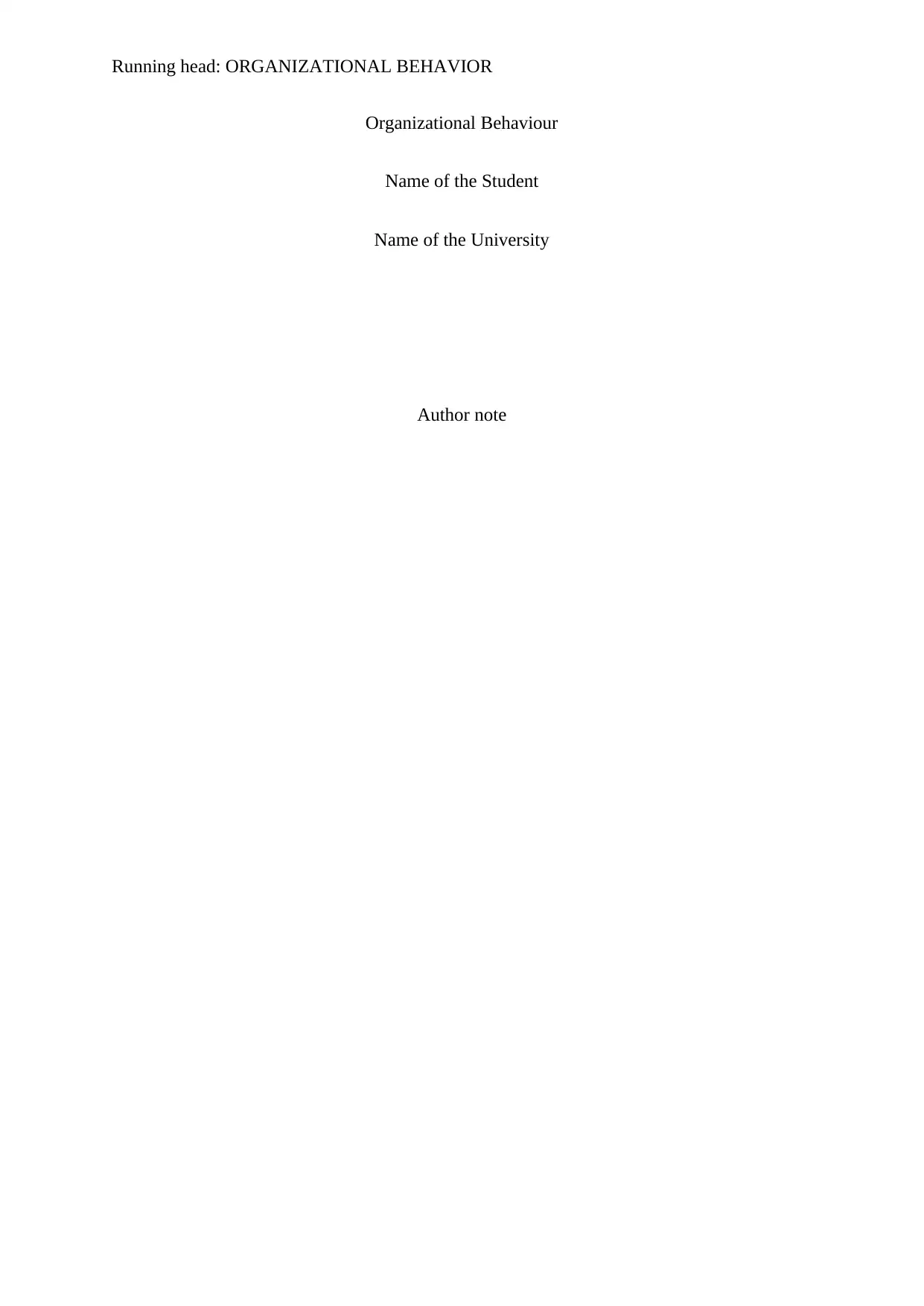
Running head: ORGANIZATIONAL BEHAVIOR
Organizational Behaviour
Name of the Student
Name of the University
Author note
Organizational Behaviour
Name of the Student
Name of the University
Author note
Paraphrase This Document
Need a fresh take? Get an instant paraphrase of this document with our AI Paraphraser
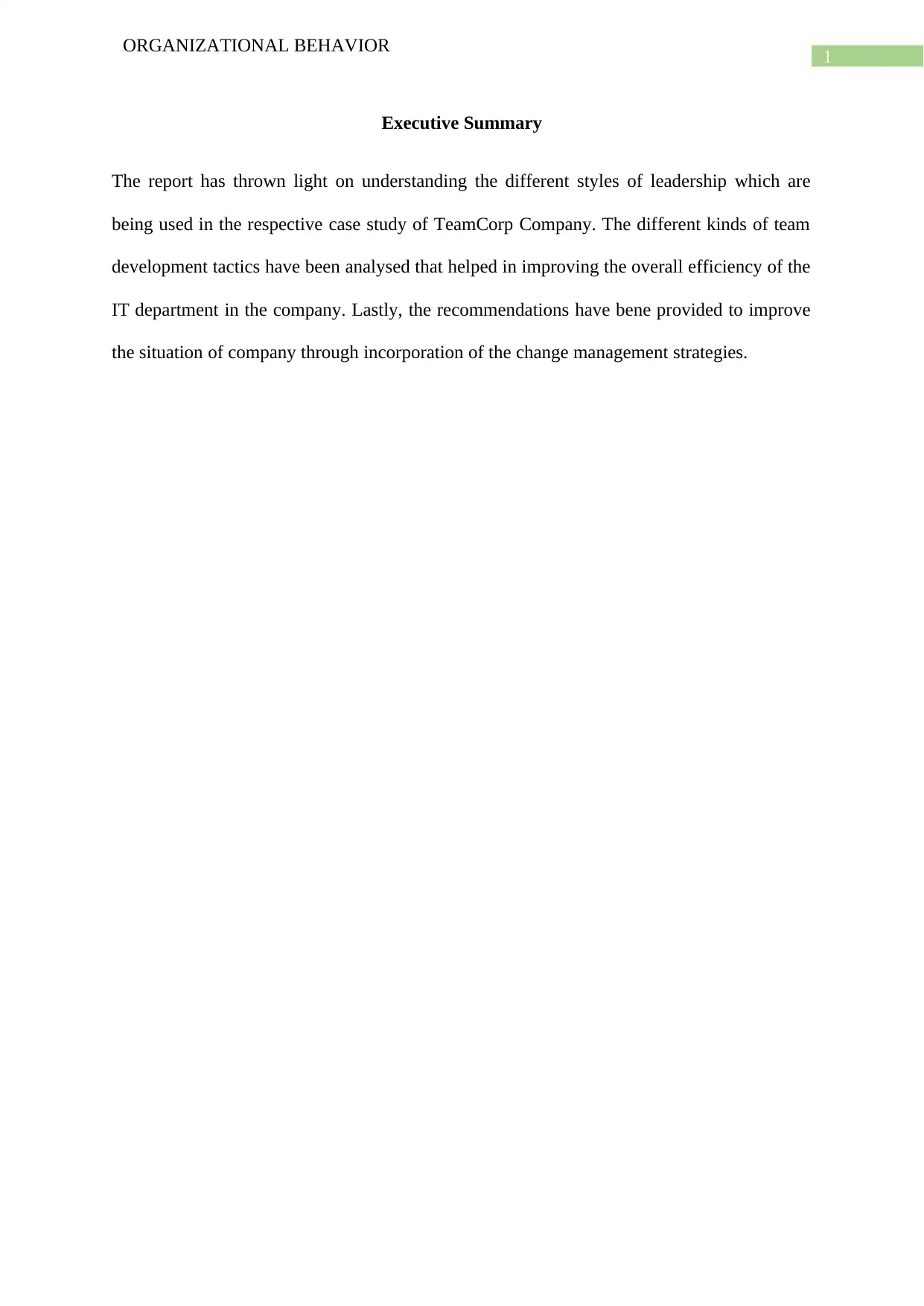
1
ORGANIZATIONAL BEHAVIOR
Executive Summary
The report has thrown light on understanding the different styles of leadership which are
being used in the respective case study of TeamCorp Company. The different kinds of team
development tactics have been analysed that helped in improving the overall efficiency of the
IT department in the company. Lastly, the recommendations have bene provided to improve
the situation of company through incorporation of the change management strategies.
ORGANIZATIONAL BEHAVIOR
Executive Summary
The report has thrown light on understanding the different styles of leadership which are
being used in the respective case study of TeamCorp Company. The different kinds of team
development tactics have been analysed that helped in improving the overall efficiency of the
IT department in the company. Lastly, the recommendations have bene provided to improve
the situation of company through incorporation of the change management strategies.
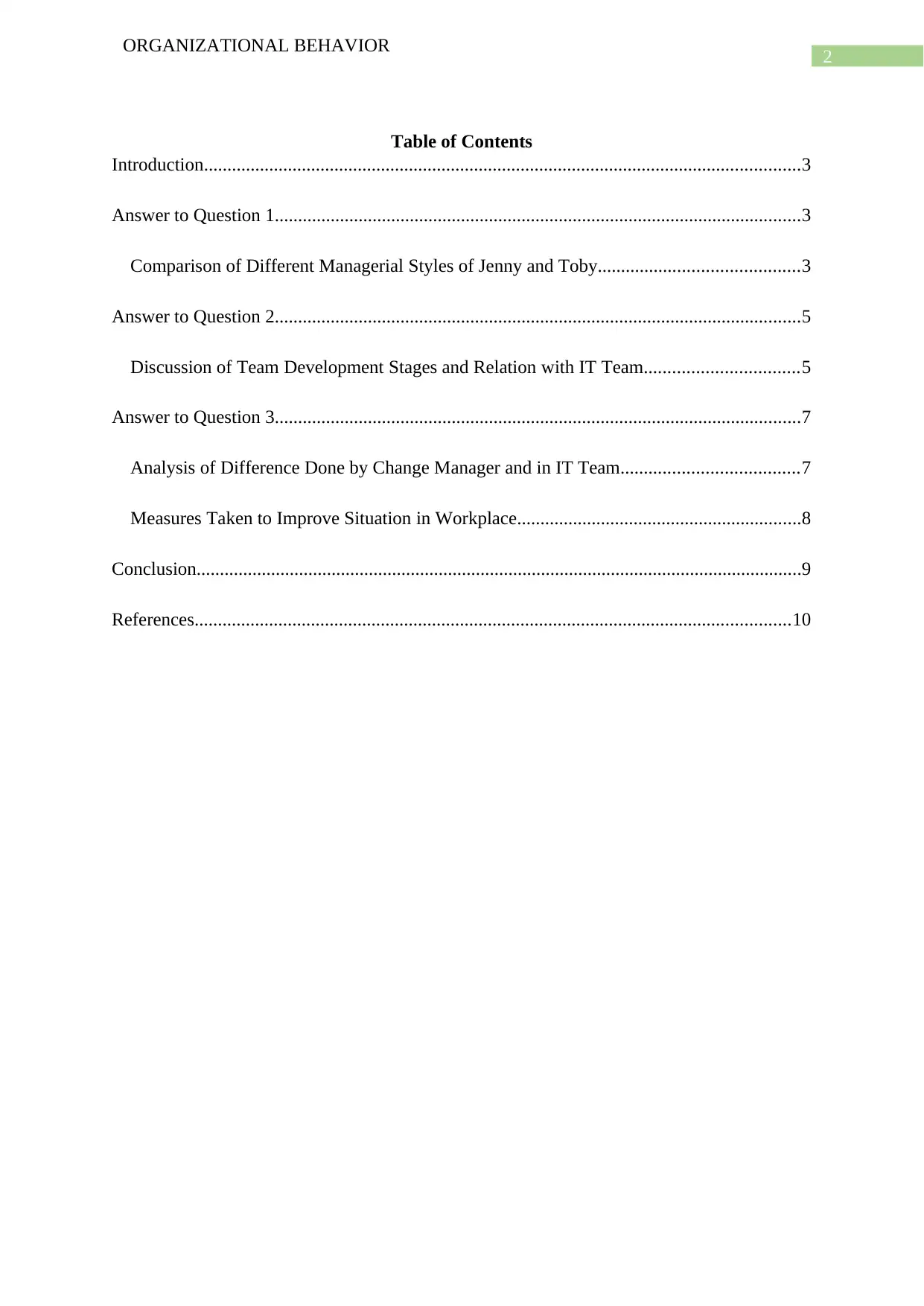
2
ORGANIZATIONAL BEHAVIOR
Table of Contents
Introduction................................................................................................................................3
Answer to Question 1.................................................................................................................3
Comparison of Different Managerial Styles of Jenny and Toby...........................................3
Answer to Question 2.................................................................................................................5
Discussion of Team Development Stages and Relation with IT Team.................................5
Answer to Question 3.................................................................................................................7
Analysis of Difference Done by Change Manager and in IT Team......................................7
Measures Taken to Improve Situation in Workplace.............................................................8
Conclusion..................................................................................................................................9
References................................................................................................................................10
ORGANIZATIONAL BEHAVIOR
Table of Contents
Introduction................................................................................................................................3
Answer to Question 1.................................................................................................................3
Comparison of Different Managerial Styles of Jenny and Toby...........................................3
Answer to Question 2.................................................................................................................5
Discussion of Team Development Stages and Relation with IT Team.................................5
Answer to Question 3.................................................................................................................7
Analysis of Difference Done by Change Manager and in IT Team......................................7
Measures Taken to Improve Situation in Workplace.............................................................8
Conclusion..................................................................................................................................9
References................................................................................................................................10
⊘ This is a preview!⊘
Do you want full access?
Subscribe today to unlock all pages.

Trusted by 1+ million students worldwide
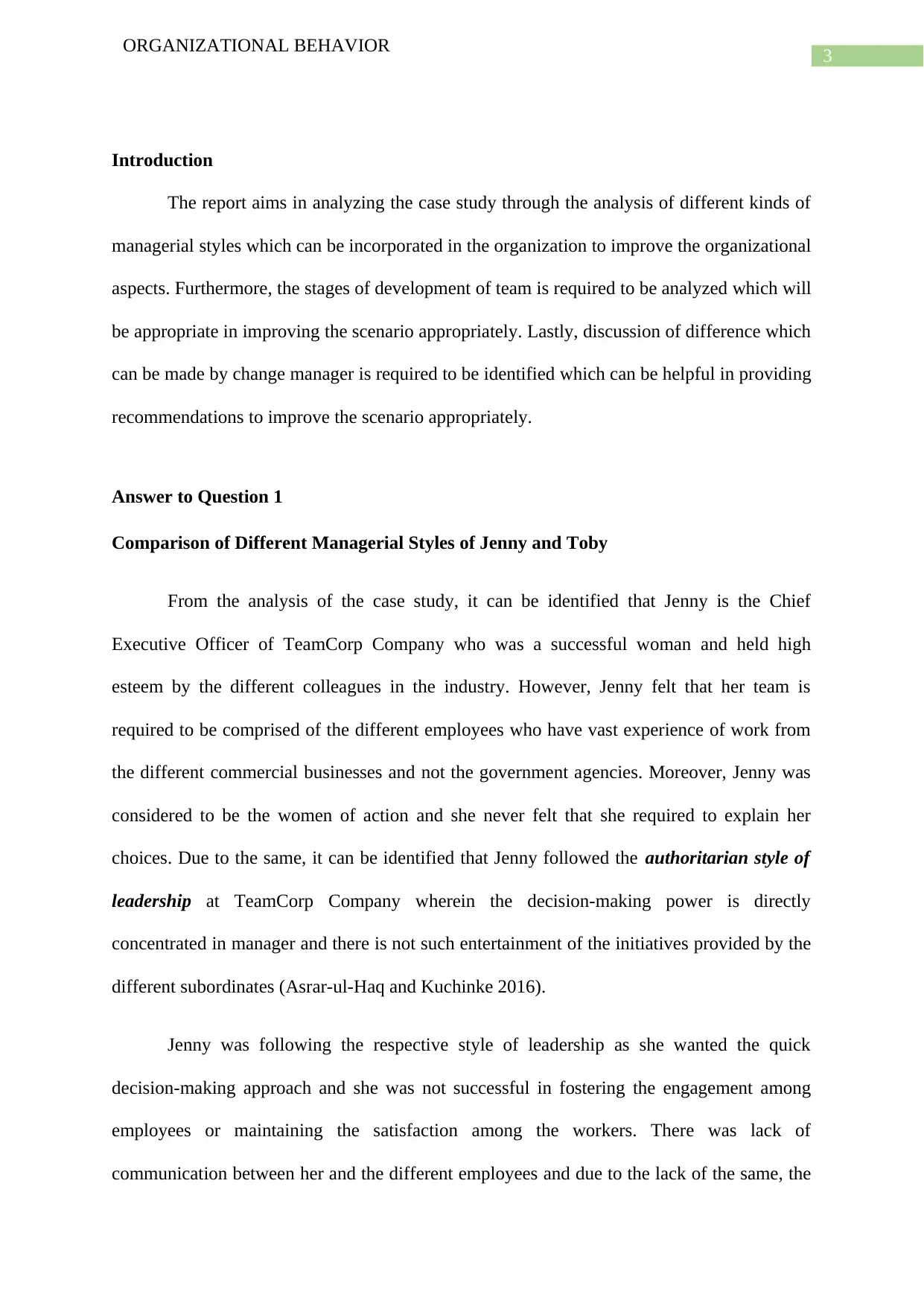
3
ORGANIZATIONAL BEHAVIOR
Introduction
The report aims in analyzing the case study through the analysis of different kinds of
managerial styles which can be incorporated in the organization to improve the organizational
aspects. Furthermore, the stages of development of team is required to be analyzed which will
be appropriate in improving the scenario appropriately. Lastly, discussion of difference which
can be made by change manager is required to be identified which can be helpful in providing
recommendations to improve the scenario appropriately.
Answer to Question 1
Comparison of Different Managerial Styles of Jenny and Toby
From the analysis of the case study, it can be identified that Jenny is the Chief
Executive Officer of TeamCorp Company who was a successful woman and held high
esteem by the different colleagues in the industry. However, Jenny felt that her team is
required to be comprised of the different employees who have vast experience of work from
the different commercial businesses and not the government agencies. Moreover, Jenny was
considered to be the women of action and she never felt that she required to explain her
choices. Due to the same, it can be identified that Jenny followed the authoritarian style of
leadership at TeamCorp Company wherein the decision-making power is directly
concentrated in manager and there is not such entertainment of the initiatives provided by the
different subordinates (Asrar-ul-Haq and Kuchinke 2016).
Jenny was following the respective style of leadership as she wanted the quick
decision-making approach and she was not successful in fostering the engagement among
employees or maintaining the satisfaction among the workers. There was lack of
communication between her and the different employees and due to the lack of the same, the
ORGANIZATIONAL BEHAVIOR
Introduction
The report aims in analyzing the case study through the analysis of different kinds of
managerial styles which can be incorporated in the organization to improve the organizational
aspects. Furthermore, the stages of development of team is required to be analyzed which will
be appropriate in improving the scenario appropriately. Lastly, discussion of difference which
can be made by change manager is required to be identified which can be helpful in providing
recommendations to improve the scenario appropriately.
Answer to Question 1
Comparison of Different Managerial Styles of Jenny and Toby
From the analysis of the case study, it can be identified that Jenny is the Chief
Executive Officer of TeamCorp Company who was a successful woman and held high
esteem by the different colleagues in the industry. However, Jenny felt that her team is
required to be comprised of the different employees who have vast experience of work from
the different commercial businesses and not the government agencies. Moreover, Jenny was
considered to be the women of action and she never felt that she required to explain her
choices. Due to the same, it can be identified that Jenny followed the authoritarian style of
leadership at TeamCorp Company wherein the decision-making power is directly
concentrated in manager and there is not such entertainment of the initiatives provided by the
different subordinates (Asrar-ul-Haq and Kuchinke 2016).
Jenny was following the respective style of leadership as she wanted the quick
decision-making approach and she was not successful in fostering the engagement among
employees or maintaining the satisfaction among the workers. There was lack of
communication between her and the different employees and due to the lack of the same, the
Paraphrase This Document
Need a fresh take? Get an instant paraphrase of this document with our AI Paraphraser
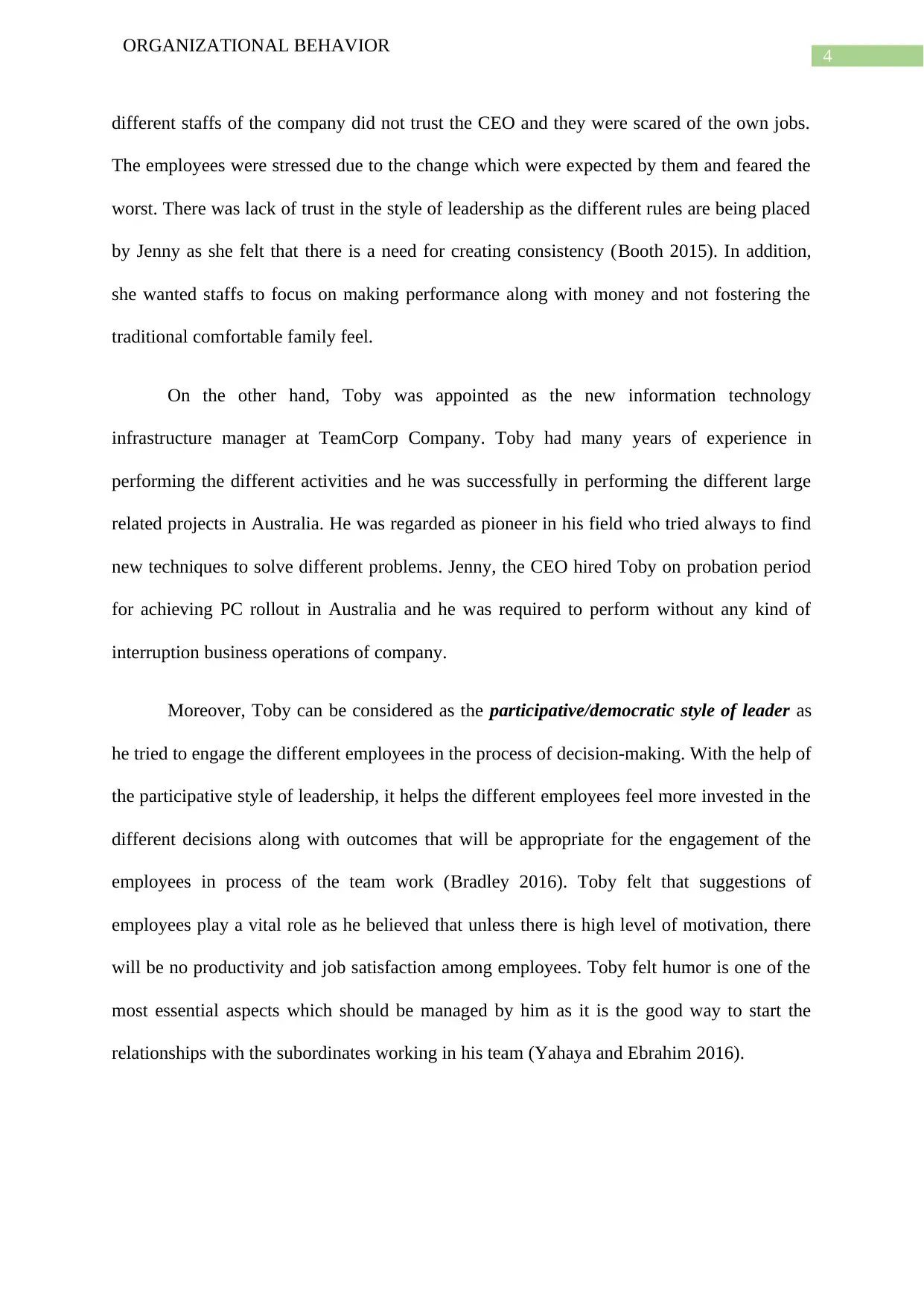
4
ORGANIZATIONAL BEHAVIOR
different staffs of the company did not trust the CEO and they were scared of the own jobs.
The employees were stressed due to the change which were expected by them and feared the
worst. There was lack of trust in the style of leadership as the different rules are being placed
by Jenny as she felt that there is a need for creating consistency (Booth 2015). In addition,
she wanted staffs to focus on making performance along with money and not fostering the
traditional comfortable family feel.
On the other hand, Toby was appointed as the new information technology
infrastructure manager at TeamCorp Company. Toby had many years of experience in
performing the different activities and he was successfully in performing the different large
related projects in Australia. He was regarded as pioneer in his field who tried always to find
new techniques to solve different problems. Jenny, the CEO hired Toby on probation period
for achieving PC rollout in Australia and he was required to perform without any kind of
interruption business operations of company.
Moreover, Toby can be considered as the participative/democratic style of leader as
he tried to engage the different employees in the process of decision-making. With the help of
the participative style of leadership, it helps the different employees feel more invested in the
different decisions along with outcomes that will be appropriate for the engagement of the
employees in process of the team work (Bradley 2016). Toby felt that suggestions of
employees play a vital role as he believed that unless there is high level of motivation, there
will be no productivity and job satisfaction among employees. Toby felt humor is one of the
most essential aspects which should be managed by him as it is the good way to start the
relationships with the subordinates working in his team (Yahaya and Ebrahim 2016).
ORGANIZATIONAL BEHAVIOR
different staffs of the company did not trust the CEO and they were scared of the own jobs.
The employees were stressed due to the change which were expected by them and feared the
worst. There was lack of trust in the style of leadership as the different rules are being placed
by Jenny as she felt that there is a need for creating consistency (Booth 2015). In addition,
she wanted staffs to focus on making performance along with money and not fostering the
traditional comfortable family feel.
On the other hand, Toby was appointed as the new information technology
infrastructure manager at TeamCorp Company. Toby had many years of experience in
performing the different activities and he was successfully in performing the different large
related projects in Australia. He was regarded as pioneer in his field who tried always to find
new techniques to solve different problems. Jenny, the CEO hired Toby on probation period
for achieving PC rollout in Australia and he was required to perform without any kind of
interruption business operations of company.
Moreover, Toby can be considered as the participative/democratic style of leader as
he tried to engage the different employees in the process of decision-making. With the help of
the participative style of leadership, it helps the different employees feel more invested in the
different decisions along with outcomes that will be appropriate for the engagement of the
employees in process of the team work (Bradley 2016). Toby felt that suggestions of
employees play a vital role as he believed that unless there is high level of motivation, there
will be no productivity and job satisfaction among employees. Toby felt humor is one of the
most essential aspects which should be managed by him as it is the good way to start the
relationships with the subordinates working in his team (Yahaya and Ebrahim 2016).
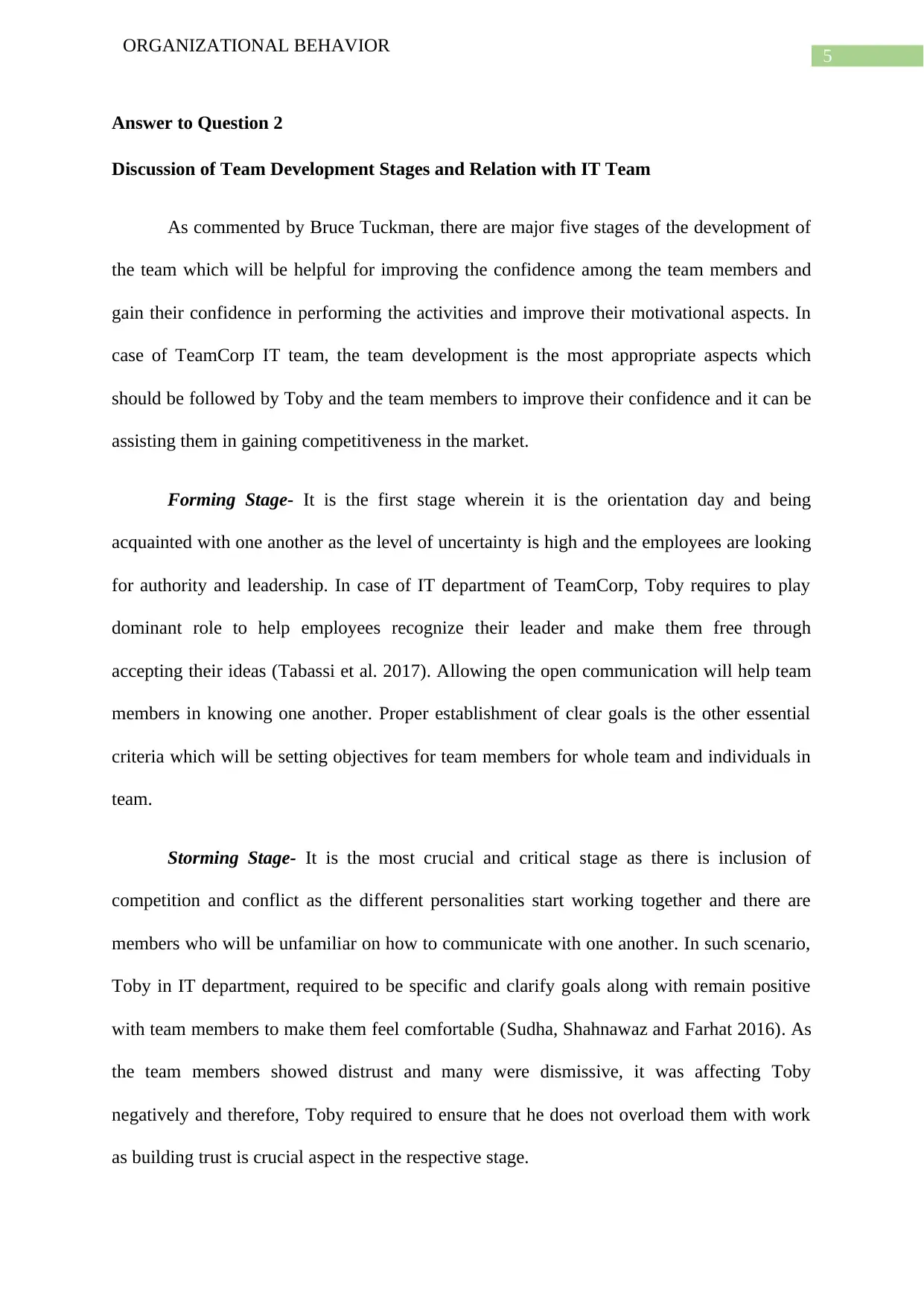
5
ORGANIZATIONAL BEHAVIOR
Answer to Question 2
Discussion of Team Development Stages and Relation with IT Team
As commented by Bruce Tuckman, there are major five stages of the development of
the team which will be helpful for improving the confidence among the team members and
gain their confidence in performing the activities and improve their motivational aspects. In
case of TeamCorp IT team, the team development is the most appropriate aspects which
should be followed by Toby and the team members to improve their confidence and it can be
assisting them in gaining competitiveness in the market.
Forming Stage- It is the first stage wherein it is the orientation day and being
acquainted with one another as the level of uncertainty is high and the employees are looking
for authority and leadership. In case of IT department of TeamCorp, Toby requires to play
dominant role to help employees recognize their leader and make them free through
accepting their ideas (Tabassi et al. 2017). Allowing the open communication will help team
members in knowing one another. Proper establishment of clear goals is the other essential
criteria which will be setting objectives for team members for whole team and individuals in
team.
Storming Stage- It is the most crucial and critical stage as there is inclusion of
competition and conflict as the different personalities start working together and there are
members who will be unfamiliar on how to communicate with one another. In such scenario,
Toby in IT department, required to be specific and clarify goals along with remain positive
with team members to make them feel comfortable (Sudha, Shahnawaz and Farhat 2016). As
the team members showed distrust and many were dismissive, it was affecting Toby
negatively and therefore, Toby required to ensure that he does not overload them with work
as building trust is crucial aspect in the respective stage.
ORGANIZATIONAL BEHAVIOR
Answer to Question 2
Discussion of Team Development Stages and Relation with IT Team
As commented by Bruce Tuckman, there are major five stages of the development of
the team which will be helpful for improving the confidence among the team members and
gain their confidence in performing the activities and improve their motivational aspects. In
case of TeamCorp IT team, the team development is the most appropriate aspects which
should be followed by Toby and the team members to improve their confidence and it can be
assisting them in gaining competitiveness in the market.
Forming Stage- It is the first stage wherein it is the orientation day and being
acquainted with one another as the level of uncertainty is high and the employees are looking
for authority and leadership. In case of IT department of TeamCorp, Toby requires to play
dominant role to help employees recognize their leader and make them free through
accepting their ideas (Tabassi et al. 2017). Allowing the open communication will help team
members in knowing one another. Proper establishment of clear goals is the other essential
criteria which will be setting objectives for team members for whole team and individuals in
team.
Storming Stage- It is the most crucial and critical stage as there is inclusion of
competition and conflict as the different personalities start working together and there are
members who will be unfamiliar on how to communicate with one another. In such scenario,
Toby in IT department, required to be specific and clarify goals along with remain positive
with team members to make them feel comfortable (Sudha, Shahnawaz and Farhat 2016). As
the team members showed distrust and many were dismissive, it was affecting Toby
negatively and therefore, Toby required to ensure that he does not overload them with work
as building trust is crucial aspect in the respective stage.
⊘ This is a preview!⊘
Do you want full access?
Subscribe today to unlock all pages.

Trusted by 1+ million students worldwide
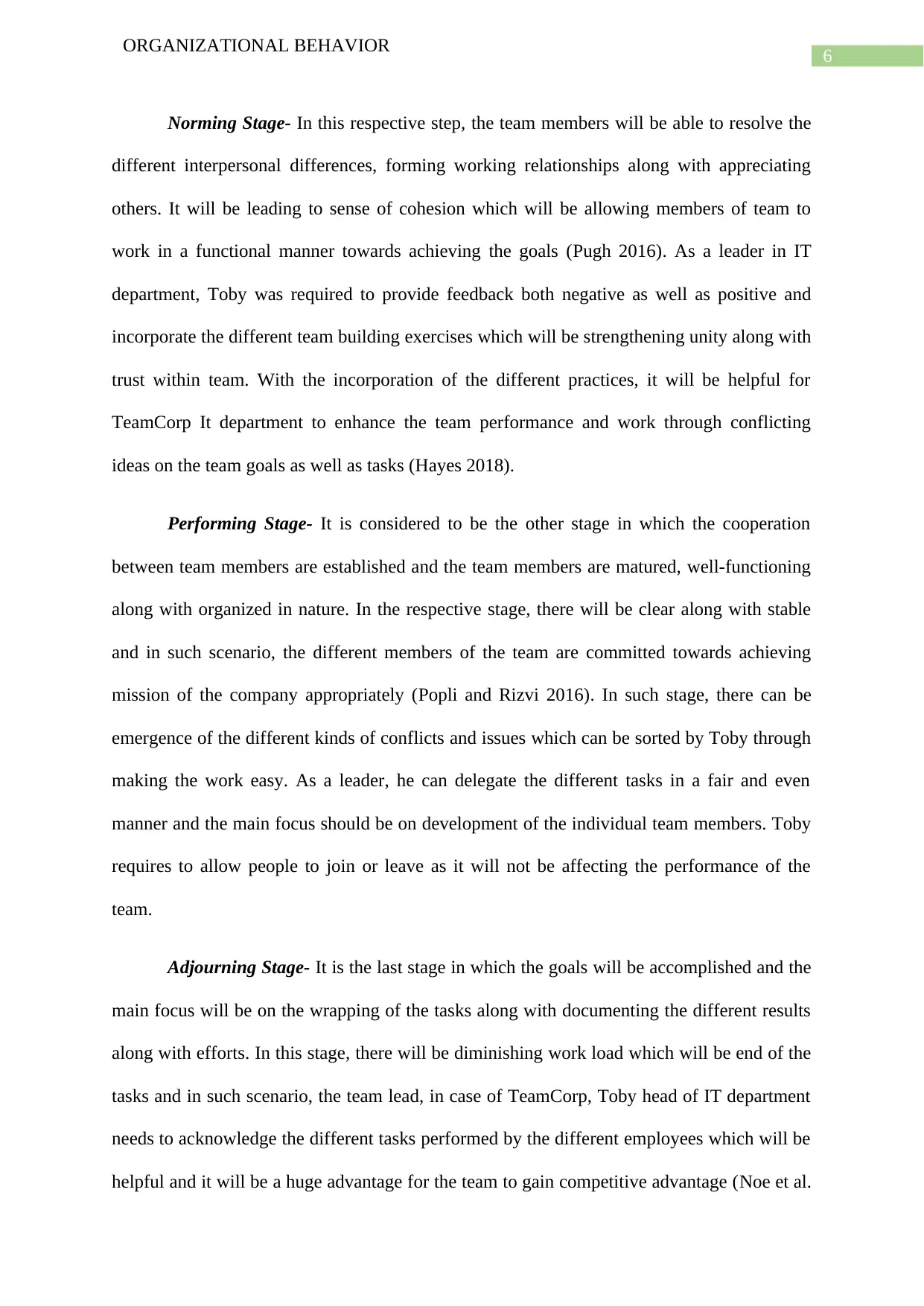
6
ORGANIZATIONAL BEHAVIOR
Norming Stage- In this respective step, the team members will be able to resolve the
different interpersonal differences, forming working relationships along with appreciating
others. It will be leading to sense of cohesion which will be allowing members of team to
work in a functional manner towards achieving the goals (Pugh 2016). As a leader in IT
department, Toby was required to provide feedback both negative as well as positive and
incorporate the different team building exercises which will be strengthening unity along with
trust within team. With the incorporation of the different practices, it will be helpful for
TeamCorp It department to enhance the team performance and work through conflicting
ideas on the team goals as well as tasks (Hayes 2018).
Performing Stage- It is considered to be the other stage in which the cooperation
between team members are established and the team members are matured, well-functioning
along with organized in nature. In the respective stage, there will be clear along with stable
and in such scenario, the different members of the team are committed towards achieving
mission of the company appropriately (Popli and Rizvi 2016). In such stage, there can be
emergence of the different kinds of conflicts and issues which can be sorted by Toby through
making the work easy. As a leader, he can delegate the different tasks in a fair and even
manner and the main focus should be on development of the individual team members. Toby
requires to allow people to join or leave as it will not be affecting the performance of the
team.
Adjourning Stage- It is the last stage in which the goals will be accomplished and the
main focus will be on the wrapping of the tasks along with documenting the different results
along with efforts. In this stage, there will be diminishing work load which will be end of the
tasks and in such scenario, the team lead, in case of TeamCorp, Toby head of IT department
needs to acknowledge the different tasks performed by the different employees which will be
helpful and it will be a huge advantage for the team to gain competitive advantage (Noe et al.
ORGANIZATIONAL BEHAVIOR
Norming Stage- In this respective step, the team members will be able to resolve the
different interpersonal differences, forming working relationships along with appreciating
others. It will be leading to sense of cohesion which will be allowing members of team to
work in a functional manner towards achieving the goals (Pugh 2016). As a leader in IT
department, Toby was required to provide feedback both negative as well as positive and
incorporate the different team building exercises which will be strengthening unity along with
trust within team. With the incorporation of the different practices, it will be helpful for
TeamCorp It department to enhance the team performance and work through conflicting
ideas on the team goals as well as tasks (Hayes 2018).
Performing Stage- It is considered to be the other stage in which the cooperation
between team members are established and the team members are matured, well-functioning
along with organized in nature. In the respective stage, there will be clear along with stable
and in such scenario, the different members of the team are committed towards achieving
mission of the company appropriately (Popli and Rizvi 2016). In such stage, there can be
emergence of the different kinds of conflicts and issues which can be sorted by Toby through
making the work easy. As a leader, he can delegate the different tasks in a fair and even
manner and the main focus should be on development of the individual team members. Toby
requires to allow people to join or leave as it will not be affecting the performance of the
team.
Adjourning Stage- It is the last stage in which the goals will be accomplished and the
main focus will be on the wrapping of the tasks along with documenting the different results
along with efforts. In this stage, there will be diminishing work load which will be end of the
tasks and in such scenario, the team lead, in case of TeamCorp, Toby head of IT department
needs to acknowledge the different tasks performed by the different employees which will be
helpful and it will be a huge advantage for the team to gain competitive advantage (Noe et al.
Paraphrase This Document
Need a fresh take? Get an instant paraphrase of this document with our AI Paraphraser
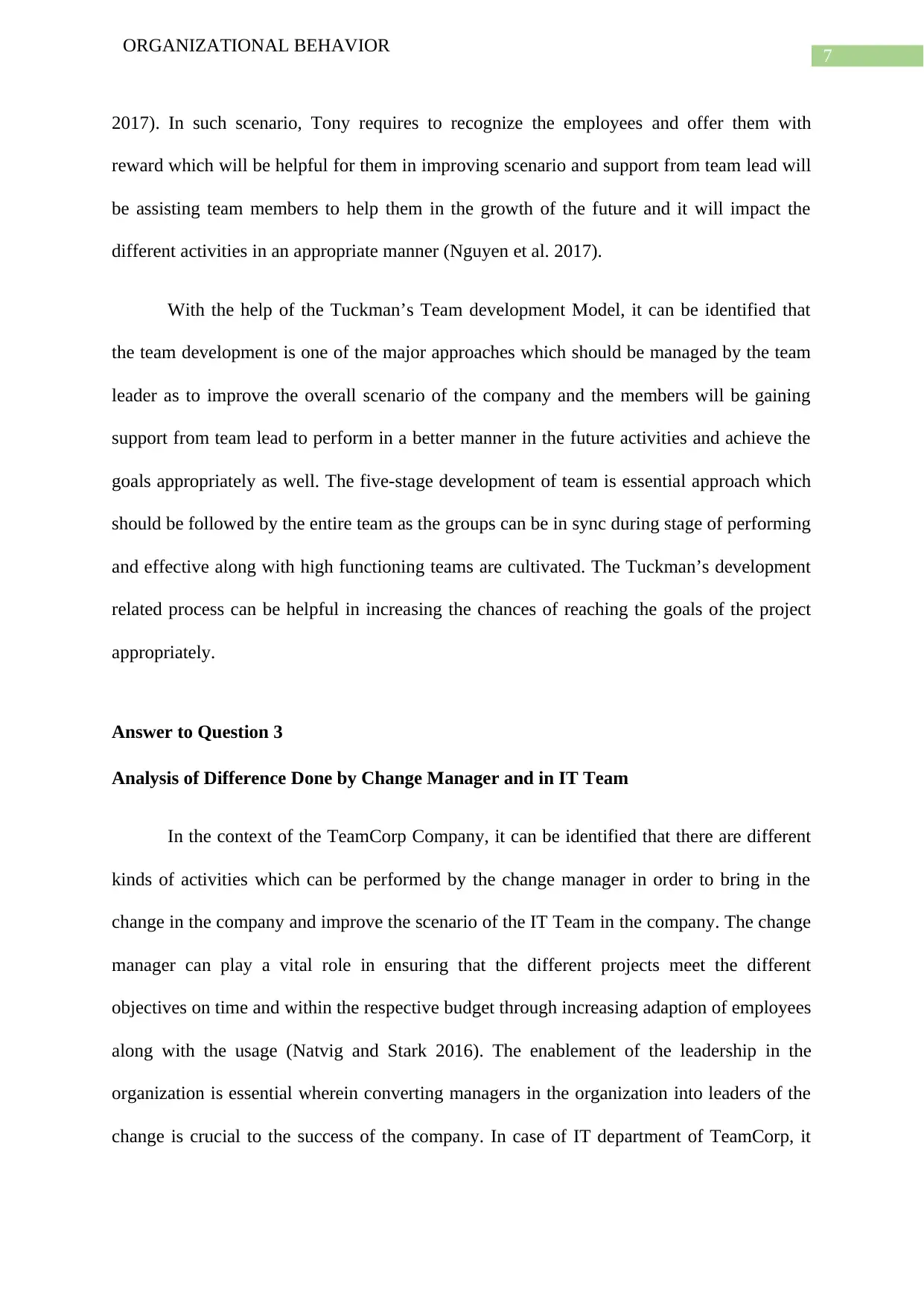
7
ORGANIZATIONAL BEHAVIOR
2017). In such scenario, Tony requires to recognize the employees and offer them with
reward which will be helpful for them in improving scenario and support from team lead will
be assisting team members to help them in the growth of the future and it will impact the
different activities in an appropriate manner (Nguyen et al. 2017).
With the help of the Tuckman’s Team development Model, it can be identified that
the team development is one of the major approaches which should be managed by the team
leader as to improve the overall scenario of the company and the members will be gaining
support from team lead to perform in a better manner in the future activities and achieve the
goals appropriately as well. The five-stage development of team is essential approach which
should be followed by the entire team as the groups can be in sync during stage of performing
and effective along with high functioning teams are cultivated. The Tuckman’s development
related process can be helpful in increasing the chances of reaching the goals of the project
appropriately.
Answer to Question 3
Analysis of Difference Done by Change Manager and in IT Team
In the context of the TeamCorp Company, it can be identified that there are different
kinds of activities which can be performed by the change manager in order to bring in the
change in the company and improve the scenario of the IT Team in the company. The change
manager can play a vital role in ensuring that the different projects meet the different
objectives on time and within the respective budget through increasing adaption of employees
along with the usage (Natvig and Stark 2016). The enablement of the leadership in the
organization is essential wherein converting managers in the organization into leaders of the
change is crucial to the success of the company. In case of IT department of TeamCorp, it
ORGANIZATIONAL BEHAVIOR
2017). In such scenario, Tony requires to recognize the employees and offer them with
reward which will be helpful for them in improving scenario and support from team lead will
be assisting team members to help them in the growth of the future and it will impact the
different activities in an appropriate manner (Nguyen et al. 2017).
With the help of the Tuckman’s Team development Model, it can be identified that
the team development is one of the major approaches which should be managed by the team
leader as to improve the overall scenario of the company and the members will be gaining
support from team lead to perform in a better manner in the future activities and achieve the
goals appropriately as well. The five-stage development of team is essential approach which
should be followed by the entire team as the groups can be in sync during stage of performing
and effective along with high functioning teams are cultivated. The Tuckman’s development
related process can be helpful in increasing the chances of reaching the goals of the project
appropriately.
Answer to Question 3
Analysis of Difference Done by Change Manager and in IT Team
In the context of the TeamCorp Company, it can be identified that there are different
kinds of activities which can be performed by the change manager in order to bring in the
change in the company and improve the scenario of the IT Team in the company. The change
manager can play a vital role in ensuring that the different projects meet the different
objectives on time and within the respective budget through increasing adaption of employees
along with the usage (Natvig and Stark 2016). The enablement of the leadership in the
organization is essential wherein converting managers in the organization into leaders of the
change is crucial to the success of the company. In case of IT department of TeamCorp, it
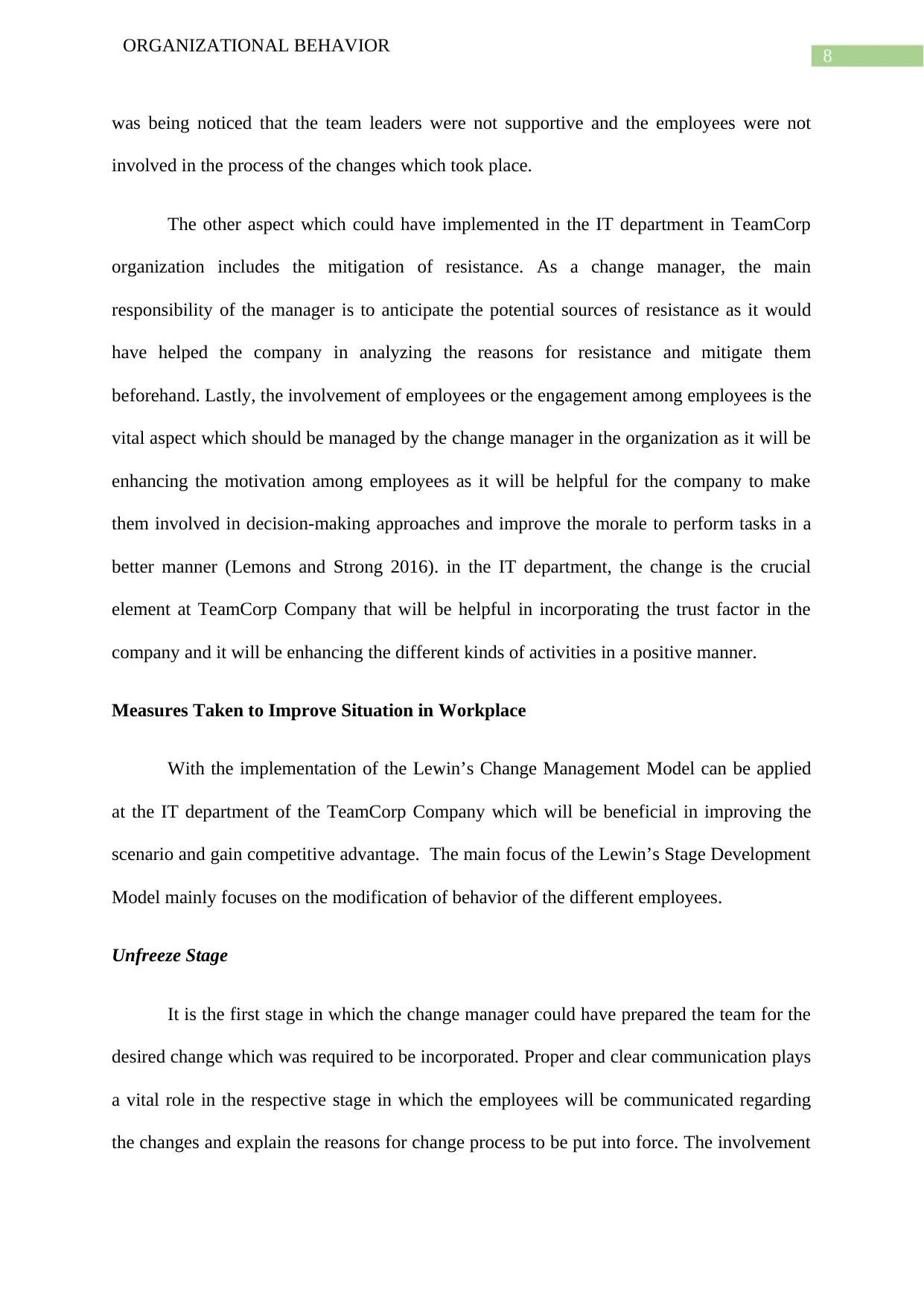
8
ORGANIZATIONAL BEHAVIOR
was being noticed that the team leaders were not supportive and the employees were not
involved in the process of the changes which took place.
The other aspect which could have implemented in the IT department in TeamCorp
organization includes the mitigation of resistance. As a change manager, the main
responsibility of the manager is to anticipate the potential sources of resistance as it would
have helped the company in analyzing the reasons for resistance and mitigate them
beforehand. Lastly, the involvement of employees or the engagement among employees is the
vital aspect which should be managed by the change manager in the organization as it will be
enhancing the motivation among employees as it will be helpful for the company to make
them involved in decision-making approaches and improve the morale to perform tasks in a
better manner (Lemons and Strong 2016). in the IT department, the change is the crucial
element at TeamCorp Company that will be helpful in incorporating the trust factor in the
company and it will be enhancing the different kinds of activities in a positive manner.
Measures Taken to Improve Situation in Workplace
With the implementation of the Lewin’s Change Management Model can be applied
at the IT department of the TeamCorp Company which will be beneficial in improving the
scenario and gain competitive advantage. The main focus of the Lewin’s Stage Development
Model mainly focuses on the modification of behavior of the different employees.
Unfreeze Stage
It is the first stage in which the change manager could have prepared the team for the
desired change which was required to be incorporated. Proper and clear communication plays
a vital role in the respective stage in which the employees will be communicated regarding
the changes and explain the reasons for change process to be put into force. The involvement
ORGANIZATIONAL BEHAVIOR
was being noticed that the team leaders were not supportive and the employees were not
involved in the process of the changes which took place.
The other aspect which could have implemented in the IT department in TeamCorp
organization includes the mitigation of resistance. As a change manager, the main
responsibility of the manager is to anticipate the potential sources of resistance as it would
have helped the company in analyzing the reasons for resistance and mitigate them
beforehand. Lastly, the involvement of employees or the engagement among employees is the
vital aspect which should be managed by the change manager in the organization as it will be
enhancing the motivation among employees as it will be helpful for the company to make
them involved in decision-making approaches and improve the morale to perform tasks in a
better manner (Lemons and Strong 2016). in the IT department, the change is the crucial
element at TeamCorp Company that will be helpful in incorporating the trust factor in the
company and it will be enhancing the different kinds of activities in a positive manner.
Measures Taken to Improve Situation in Workplace
With the implementation of the Lewin’s Change Management Model can be applied
at the IT department of the TeamCorp Company which will be beneficial in improving the
scenario and gain competitive advantage. The main focus of the Lewin’s Stage Development
Model mainly focuses on the modification of behavior of the different employees.
Unfreeze Stage
It is the first stage in which the change manager could have prepared the team for the
desired change which was required to be incorporated. Proper and clear communication plays
a vital role in the respective stage in which the employees will be communicated regarding
the changes and explain the reasons for change process to be put into force. The involvement
⊘ This is a preview!⊘
Do you want full access?
Subscribe today to unlock all pages.

Trusted by 1+ million students worldwide
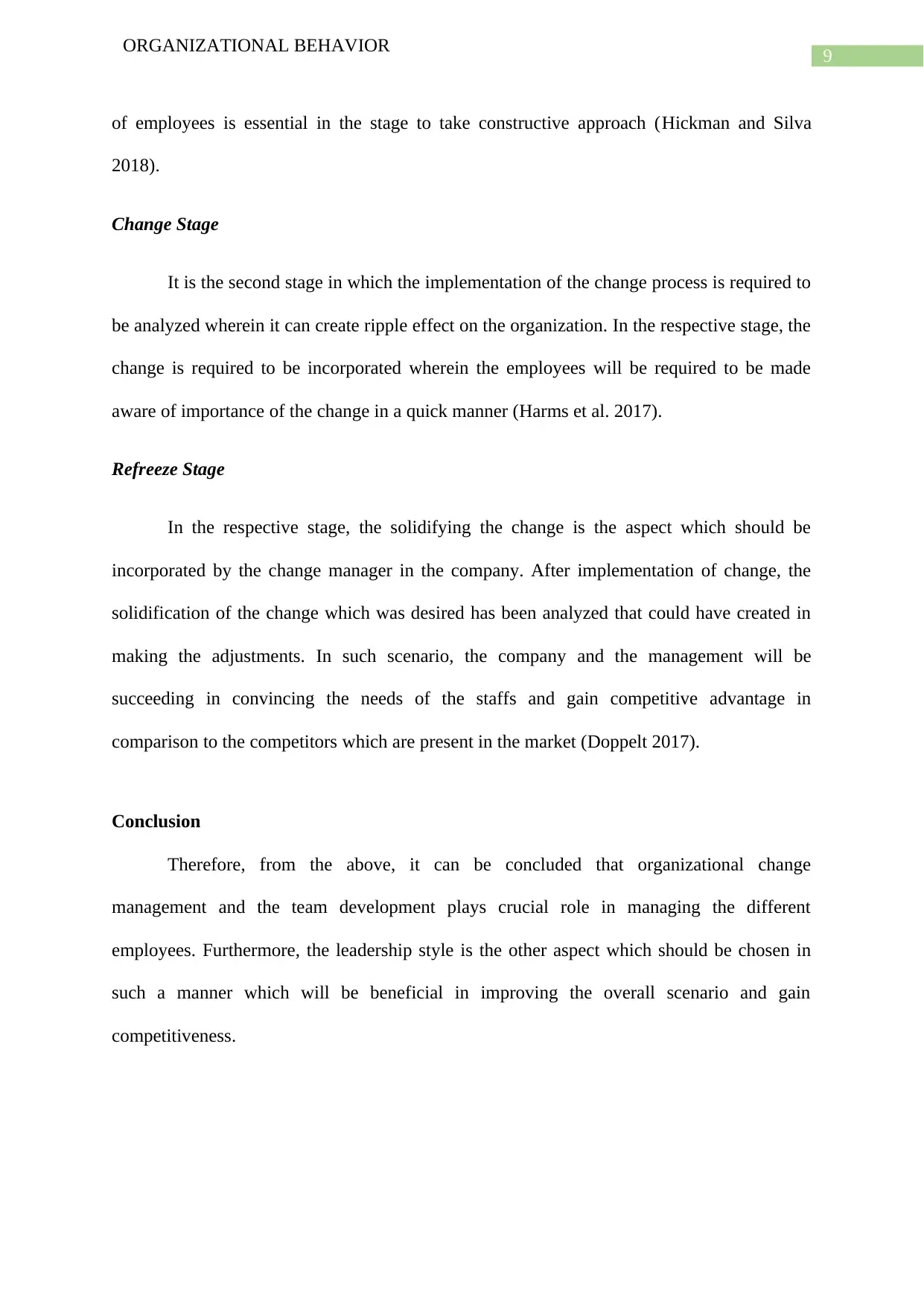
9
ORGANIZATIONAL BEHAVIOR
of employees is essential in the stage to take constructive approach (Hickman and Silva
2018).
Change Stage
It is the second stage in which the implementation of the change process is required to
be analyzed wherein it can create ripple effect on the organization. In the respective stage, the
change is required to be incorporated wherein the employees will be required to be made
aware of importance of the change in a quick manner (Harms et al. 2017).
Refreeze Stage
In the respective stage, the solidifying the change is the aspect which should be
incorporated by the change manager in the company. After implementation of change, the
solidification of the change which was desired has been analyzed that could have created in
making the adjustments. In such scenario, the company and the management will be
succeeding in convincing the needs of the staffs and gain competitive advantage in
comparison to the competitors which are present in the market (Doppelt 2017).
Conclusion
Therefore, from the above, it can be concluded that organizational change
management and the team development plays crucial role in managing the different
employees. Furthermore, the leadership style is the other aspect which should be chosen in
such a manner which will be beneficial in improving the overall scenario and gain
competitiveness.
ORGANIZATIONAL BEHAVIOR
of employees is essential in the stage to take constructive approach (Hickman and Silva
2018).
Change Stage
It is the second stage in which the implementation of the change process is required to
be analyzed wherein it can create ripple effect on the organization. In the respective stage, the
change is required to be incorporated wherein the employees will be required to be made
aware of importance of the change in a quick manner (Harms et al. 2017).
Refreeze Stage
In the respective stage, the solidifying the change is the aspect which should be
incorporated by the change manager in the company. After implementation of change, the
solidification of the change which was desired has been analyzed that could have created in
making the adjustments. In such scenario, the company and the management will be
succeeding in convincing the needs of the staffs and gain competitive advantage in
comparison to the competitors which are present in the market (Doppelt 2017).
Conclusion
Therefore, from the above, it can be concluded that organizational change
management and the team development plays crucial role in managing the different
employees. Furthermore, the leadership style is the other aspect which should be chosen in
such a manner which will be beneficial in improving the overall scenario and gain
competitiveness.
Paraphrase This Document
Need a fresh take? Get an instant paraphrase of this document with our AI Paraphraser
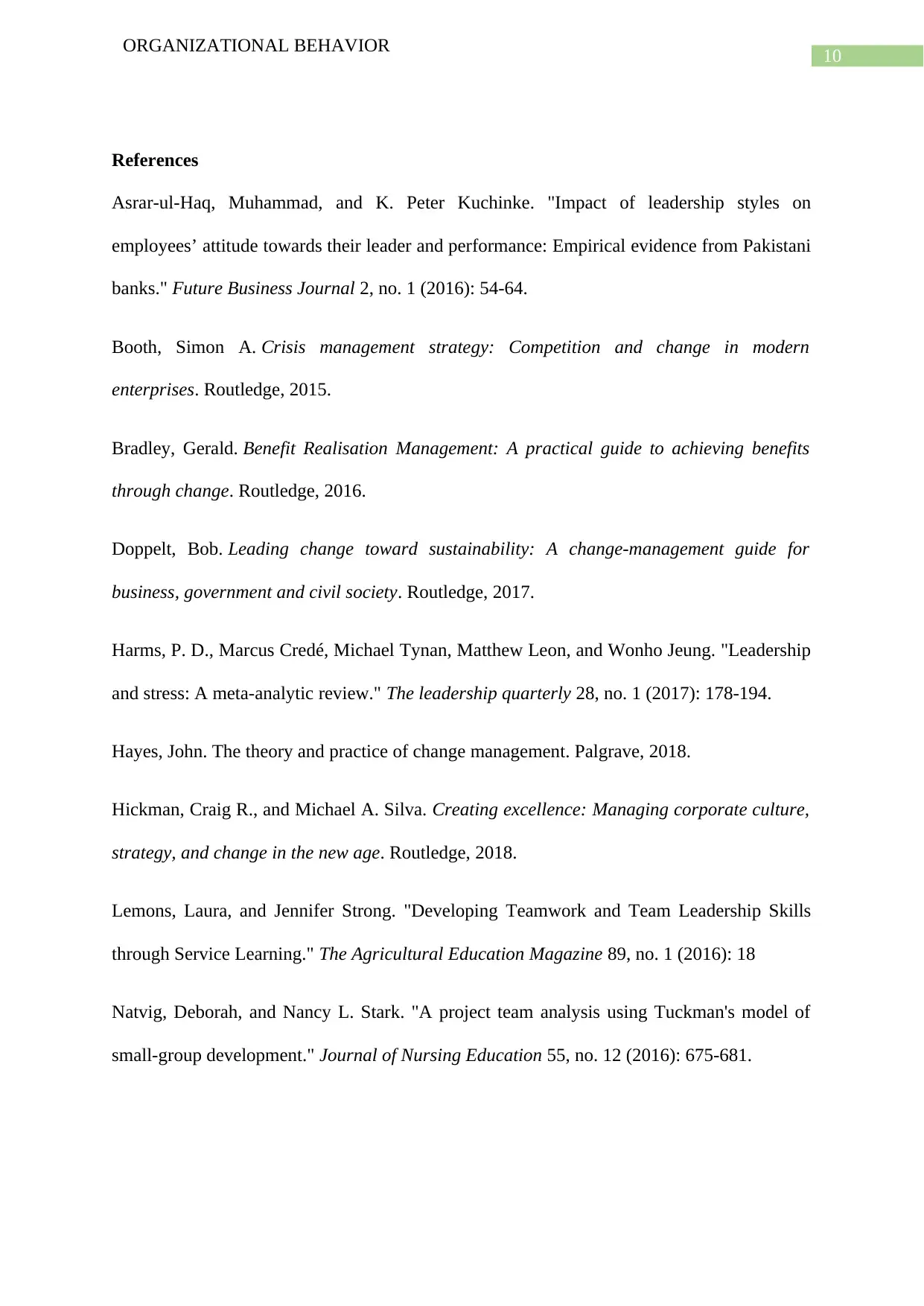
10
ORGANIZATIONAL BEHAVIOR
References
Asrar-ul-Haq, Muhammad, and K. Peter Kuchinke. "Impact of leadership styles on
employees’ attitude towards their leader and performance: Empirical evidence from Pakistani
banks." Future Business Journal 2, no. 1 (2016): 54-64.
Booth, Simon A. Crisis management strategy: Competition and change in modern
enterprises. Routledge, 2015.
Bradley, Gerald. Benefit Realisation Management: A practical guide to achieving benefits
through change. Routledge, 2016.
Doppelt, Bob. Leading change toward sustainability: A change-management guide for
business, government and civil society. Routledge, 2017.
Harms, P. D., Marcus Credé, Michael Tynan, Matthew Leon, and Wonho Jeung. "Leadership
and stress: A meta-analytic review." The leadership quarterly 28, no. 1 (2017): 178-194.
Hayes, John. The theory and practice of change management. Palgrave, 2018.
Hickman, Craig R., and Michael A. Silva. Creating excellence: Managing corporate culture,
strategy, and change in the new age. Routledge, 2018.
Lemons, Laura, and Jennifer Strong. "Developing Teamwork and Team Leadership Skills
through Service Learning." The Agricultural Education Magazine 89, no. 1 (2016): 18
Natvig, Deborah, and Nancy L. Stark. "A project team analysis using Tuckman's model of
small-group development." Journal of Nursing Education 55, no. 12 (2016): 675-681.
ORGANIZATIONAL BEHAVIOR
References
Asrar-ul-Haq, Muhammad, and K. Peter Kuchinke. "Impact of leadership styles on
employees’ attitude towards their leader and performance: Empirical evidence from Pakistani
banks." Future Business Journal 2, no. 1 (2016): 54-64.
Booth, Simon A. Crisis management strategy: Competition and change in modern
enterprises. Routledge, 2015.
Bradley, Gerald. Benefit Realisation Management: A practical guide to achieving benefits
through change. Routledge, 2016.
Doppelt, Bob. Leading change toward sustainability: A change-management guide for
business, government and civil society. Routledge, 2017.
Harms, P. D., Marcus Credé, Michael Tynan, Matthew Leon, and Wonho Jeung. "Leadership
and stress: A meta-analytic review." The leadership quarterly 28, no. 1 (2017): 178-194.
Hayes, John. The theory and practice of change management. Palgrave, 2018.
Hickman, Craig R., and Michael A. Silva. Creating excellence: Managing corporate culture,
strategy, and change in the new age. Routledge, 2018.
Lemons, Laura, and Jennifer Strong. "Developing Teamwork and Team Leadership Skills
through Service Learning." The Agricultural Education Magazine 89, no. 1 (2016): 18
Natvig, Deborah, and Nancy L. Stark. "A project team analysis using Tuckman's model of
small-group development." Journal of Nursing Education 55, no. 12 (2016): 675-681.
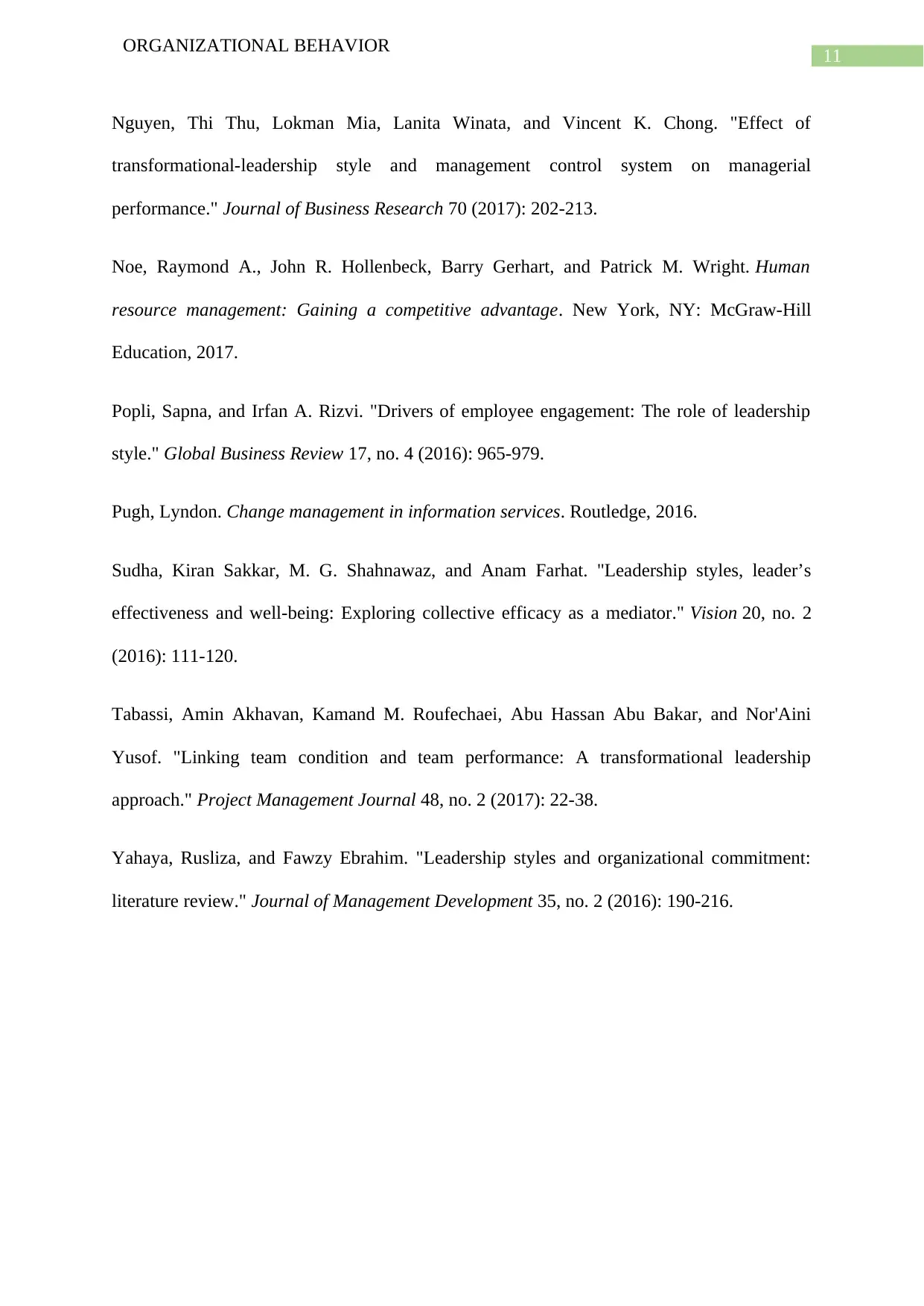
11
ORGANIZATIONAL BEHAVIOR
Nguyen, Thi Thu, Lokman Mia, Lanita Winata, and Vincent K. Chong. "Effect of
transformational-leadership style and management control system on managerial
performance." Journal of Business Research 70 (2017): 202-213.
Noe, Raymond A., John R. Hollenbeck, Barry Gerhart, and Patrick M. Wright. Human
resource management: Gaining a competitive advantage. New York, NY: McGraw-Hill
Education, 2017.
Popli, Sapna, and Irfan A. Rizvi. "Drivers of employee engagement: The role of leadership
style." Global Business Review 17, no. 4 (2016): 965-979.
Pugh, Lyndon. Change management in information services. Routledge, 2016.
Sudha, Kiran Sakkar, M. G. Shahnawaz, and Anam Farhat. "Leadership styles, leader’s
effectiveness and well-being: Exploring collective efficacy as a mediator." Vision 20, no. 2
(2016): 111-120.
Tabassi, Amin Akhavan, Kamand M. Roufechaei, Abu Hassan Abu Bakar, and Nor'Aini
Yusof. "Linking team condition and team performance: A transformational leadership
approach." Project Management Journal 48, no. 2 (2017): 22-38.
Yahaya, Rusliza, and Fawzy Ebrahim. "Leadership styles and organizational commitment:
literature review." Journal of Management Development 35, no. 2 (2016): 190-216.
ORGANIZATIONAL BEHAVIOR
Nguyen, Thi Thu, Lokman Mia, Lanita Winata, and Vincent K. Chong. "Effect of
transformational-leadership style and management control system on managerial
performance." Journal of Business Research 70 (2017): 202-213.
Noe, Raymond A., John R. Hollenbeck, Barry Gerhart, and Patrick M. Wright. Human
resource management: Gaining a competitive advantage. New York, NY: McGraw-Hill
Education, 2017.
Popli, Sapna, and Irfan A. Rizvi. "Drivers of employee engagement: The role of leadership
style." Global Business Review 17, no. 4 (2016): 965-979.
Pugh, Lyndon. Change management in information services. Routledge, 2016.
Sudha, Kiran Sakkar, M. G. Shahnawaz, and Anam Farhat. "Leadership styles, leader’s
effectiveness and well-being: Exploring collective efficacy as a mediator." Vision 20, no. 2
(2016): 111-120.
Tabassi, Amin Akhavan, Kamand M. Roufechaei, Abu Hassan Abu Bakar, and Nor'Aini
Yusof. "Linking team condition and team performance: A transformational leadership
approach." Project Management Journal 48, no. 2 (2017): 22-38.
Yahaya, Rusliza, and Fawzy Ebrahim. "Leadership styles and organizational commitment:
literature review." Journal of Management Development 35, no. 2 (2016): 190-216.
⊘ This is a preview!⊘
Do you want full access?
Subscribe today to unlock all pages.

Trusted by 1+ million students worldwide
1 out of 12
Related Documents
Your All-in-One AI-Powered Toolkit for Academic Success.
+13062052269
info@desklib.com
Available 24*7 on WhatsApp / Email
![[object Object]](/_next/static/media/star-bottom.7253800d.svg)
Unlock your academic potential
Copyright © 2020–2025 A2Z Services. All Rights Reserved. Developed and managed by ZUCOL.




